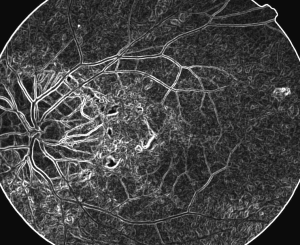Intravitreal bevacizumab as primary treatment for retinal angiomatous proliferation: twelve-month results.
PURPOSE:
To evaluate the short-term efficacy and safety of intravitreal bevacizumab for the treatment of retinal angiomatous proliferation.
METHODS:
Seventeen eyes from 16 patients with newly diagnosed retinal angiomatous proliferation underwent intravitreal injections of bevacizumab, 1.25 mg. The patients were scheduled for three monthly bevacizumab injections. Early Treatment of Diabetic Retinopathy Study (ETDRS) best-corrected visual acuity, central macular thickness on optical coherence tomography, and fluorescein angiographic findings were examined before and after treatment. Patients were followed-up for 12 months.
RESULTS:
The mean best-corrected visual acuity (+/- standard deviation [SD]) at baseline was 39.53 (+/-10.40) letters (Snellen equivalent: 20/42). At 12 months after treatment the mean best-corrected visual acuity (+/-SD) improved significantly (P = 0.0000001) to 47.88 (+/-11.78) letters (Snellen equivalent: 20/28). Best-corrected visual acuity improved 3 ETDRS lines or more in 3 (17.65%) of 17 treated eyes, 14 (82.35%) eyes were stable, and 15 (88.23%) eyes gained 1 or more ETDRS lines. The mean central macular thickness (+/-SD) at baseline was 297 (+/-60.72) microm. At 12 months after treatment, the mean central macular thickness (+/-SD) reduced significantly (P = 0.00001) to 237 (+/-28.80) microm. At the 12-month follow-up, absence of fluorescein leakage was demonstrated in 14 (82%) of 17 treated eyes. No ocular or systemic adverse effects from treatment were encountered.
CONCLUSION:
The 12-month results of intravitreal bevacizumab for retinal angiomatous proliferation are very promising with no apparent short-term safety concerns. Treated eyes had a significant functional and anatomical improvement. Further studies will be needed to better determine long-term efficacy and safety.
http://www.ncbi.nlm.nih.gov/pubmed/19516116

